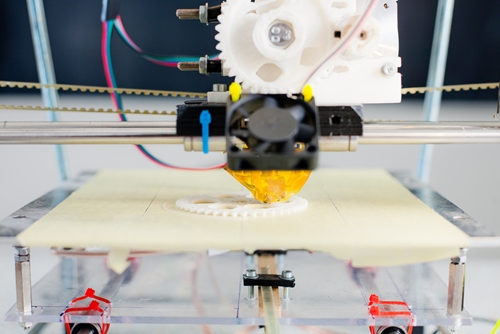According to separate reports from market research firms Gartner and Allied Market Research, the medical 3-D printing market is poised to explode over the next four years. Gartner projects the global market will grow from $1.6 billion to $13.4 billion by 2018, reported Forbes. Analysts at Allied Market Research offered more measured projection, reporting that it will grow to $8.6 billion by 2020.
Both firms attribute this projected growth to the development of new 3-D printing technologies and an industry-wide effort to lower equipment costs. According to Wired, the Massachusetts Institute of Technology recently achieved this ideal balance with its MultiFab platform, an advanced multimaterial printer made of low-price, prefabricated parts. The machine costs $7,000. Comparable printers are sold for around $250,000.
Medical imaging departments and practices will surely play a part in the industry's growth. Radiologists long ago latched onto 3-D printing and, according to professional organizations within the specialty, they plan to see it through to its full potential.
The Early Adopters
According to Crain's Chicago Business, many imaging professionals already use 3-D printers in clinical settings. Normally, they convert computerized tomography or magnetic resonance imaging scans into 3-D models for pre-surgical preparation, a practice that has revolutionized the operating room.
"The overall direction is to make complex operations simpler," Dr. Bohdan Pomahac, a surgeon at Brigham & Women's Hospital, said in an interview with the publication. "This may be one of the most profound tools that we hope to use in the coming future."
Texas Children's Hospital fully embraced this technique. The hospital's Department of Pediatric Radiology uses a full suite of 3-D printers to develop models. And during a presentation at the Radiological Society of North America's annual meeting in December, radiologists from the hospital showed what they could achieve. The department produced 3-D models that surgeons used to plan a complex operation to separate conjoined twins. The procedure was a success and the first of its kind. The models proved essential.
"The surgeons found the landmarks for the liver, hearts and pelvic organs just as we had described," Dr. Rajesh Krishnamurthy, chief of radiology research and cardiac imaging at the hospital, said in a news release. "The concordance was almost perfect."
Other institutions, including Boston Children's Hospital and Ottawa Hospital, have also integrated 3-D printing into their medical imaging departments, reported The New York Times.
A Specialty-Wide Craze
Krishnamurthy was one of many imaging professionals addressing the topic of 3-D printing at RSNA 2015. The conference included information and training sessions on the subject, many of which sold out, reported Diagnostic Imaging. And vendors displayed 3-D models and printers. Attendees seemed to be completely swept up in the trend.
3-D printing was also a key concern for radiologists who attended the Society of Interventional Radiology meeting this past July, reported AuntMinnie.com. Attendees examined a variety of custom-printed medical devices that could be tailored to flawlessly fit any patient.
"Although these successes are early successes, we believe that our findings with this technology highlight the limitless potential of interventional radiology to offer patient-centered care," Dr. Horatio D'Agostino, chair of radiology and director of interventional radiology at the Louisiana State University Health Sciences Center, told the publication.
According to experts, radiologists are attracted to 3-D printing because it allows them to provide more products and services. Imaging departments with this technology can produce 3-D surgical plans, patient-specific prostheses and detailed training models.
Tying Up The Loose Ends
Despite this fervor, a number of roadblocks lie in the way of specialty-wide adoption. According to the RSNA, cost is still a major concern for imaging professionals looking to adopt the technology. Apart from MultiFab, which is still in its experimental stages and not made for mass production, there are no low-price 3-D printing options. Implementation adds more expenses to the equation. Even imaging departments simply testing the water will incur costs by devoting staff to developmental efforts.
Additionally, the federal government has been slow to react to the ascendant rise of 3-D printing within the health care industry. As a result, there are few funding opportunities. On the positive side, the U.S. Food and Drug Administration is open to the idea and has approved printed pharmaceuticals and prosthetics, reported The Washington Post.
Training is also a problem. Radiologists already work with complex technology like PACS, but 3-D printer software is an entirely different animal. And, due to high material costs, the margin of error in training sessions will be slim.
Proponents of medical 3-D printing say these problems will resolve themselves as the market strengthens. The latest projections from Gartner and analysts at Allied Market Research buttress these claims.
"The price of printing will come down. The number of printers out there is increasing. The utility is increasing. The software is improving. And the prices are dropping with all computers, so I anticipate the overall price will drop," Dr. John Hibbeln, section director of Informatics at Rush University Medical Center, told RSNA. "3-D printing has tremendous potential. Like so much else in the world, the only constraints are money and inventiveness."
Contact Viztek for more information.
Ronny Bachrach
Latest posts by Ronny Bachrach (see all)
- Konica Minolta Debuts First-of-Its-Kind Digital U-Arm System at AHRA - July 27, 2016
- Researchers Detect Signs Of Stroke Risk Using MRI - June 27, 2016
- Imaging Biz: Q&A with David S. Channin MD: How to Make PACS Patient Centered - June 22, 2016










